Power Kites-Buggy Engines
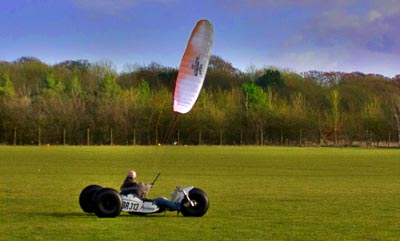
Power Kiting
There are hundreds of styles and sizes to choose from, and many reputable manufactures to purchase your power kite from, some of the top names in this sport are HQ, Peter Lynn, Flexifoil, Ozone, PKD and Pansh to name a few, they can range in price from around £100.00 to over £2000 for some of the larger depower kites, but you can always find some good deals on 2nd hand Kites on power kiting forums around the world. This page may well not have all the answers you are looking for, but it is designed to give you more of an insight to what a Power Kite is and why we use these powerful pieces of ripstop to power us along.
They come in three main forms: foils, leading edge inflatables and supported leading edge. There are also rigid-framed kites and soft single skin kites. There are several different control systems used with these kites which have two to five lines and a bar or handles. Most foil kites are made for use on land as they are “opened celled” so air flows in and out easily, this can be used as a safety feature to depower the kite. There are a few exceptions for this with new foils that use closed cell technology; they float on the water while you relaunch.
Power kites are generally used in conjunction with a vehicle or board, such as in:
- kitesurfing on a kiteboard
- kite buggying on a purpose-built 3-wheeled cart
- kite landboarding on an all-terrain/mountain/land board
- kite skating on all-terrain roller skates
- snowkiting on skis or snowboards
- kite jumping, using a power kite for jumping above the ground
- kiteboating, on a boat
Research is also under way in the use of kites to generate electric power to be fed into a power grid. Kites can be used to reach high altitude winds such as a jet stream, which are always present, even if ground level winds available to wind turbines are absent.
Foil Kites
Foil kites are made mostly of fabric, typically 2 layers of ripstop nylon. The layers are sewn with air pockets that open in the front, allowing them to fill with air and thereby give the kite its wing-like airfoil shape. The control and power lines of a foil kite are not attached directly to the kite but attach instead to a wide series of smaller lines which are attached to many points on the kite, forming what’s called a bridle. The bridle further helps the kite keep its shape and also provides better flight control.
Foil kites are usually flown over land, because if they crash in the water, the pockets can fill with water and it becomes impossible to re-launch the kite. The advantage of foil kites is that they fold up small and set up quickly and easily. And since they don’t have bladders and heavy Dacron reinforcement, they are lighter and less prone to damage during hard crashes or travel.
Leading Edge Inflatable Kites (LEI Kites)
Leading edge inflatable (LEI) kites have only one layer of ripstop nylon with Dacron and other reinforcements in high-wear or high-load areas. They keep their shape by using inflatable bladders made from TPU (Thermoplastic Polyurethane) that are sewn into compartments in the leading edge and the struts that extend from the leading edge to the rear of the kite. When inflated with a hand pump, these bladders provide the kite with a semi-rigid skeleton or frame. These kites almost always use a control bar instead of handles, and they have either 4 or 5 lines. They are the primary type of kite used over water, because the inflatable bladders keep the kites shape and float, allowing the kite to be more easily re-launched after a crash.
Depower Kites
A depower kite is, as the name suggests, one where the kite flier can control the power output of the kite.
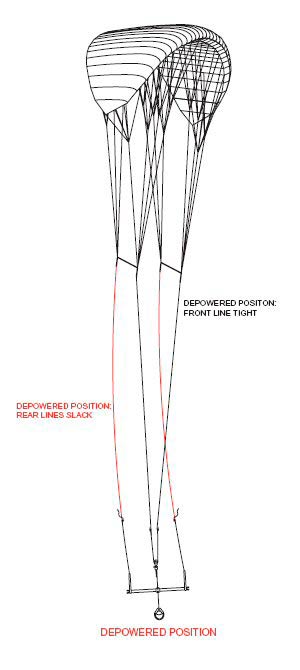 A depower kite works by changing the angle of attack of the kite. Basically, a kite can be thought of as an airplane wing. When an airplane is flying normally, the wing is in a more or less flat position, providing lift to keep the plane in the air, but also reducing drag to allow the plane to fly faster. However, when a plane is taking off, it needs more lift to get into the air, whilst speed isn’t so important. The wing is tilted upwards as the plane takes off, giving the necessary lift. When the plane levels off, it goes into speed mode.
A depower kite works by changing the angle of attack of the kite. Basically, a kite can be thought of as an airplane wing. When an airplane is flying normally, the wing is in a more or less flat position, providing lift to keep the plane in the air, but also reducing drag to allow the plane to fly faster. However, when a plane is taking off, it needs more lift to get into the air, whilst speed isn’t so important. The wing is tilted upwards as the plane takes off, giving the necessary lift. When the plane levels off, it goes into speed mode.
In a kiting context, this means that when the kite is tilted flat to the wind (as above) the lift and power is at a minimum, but because drag is decreased, the airspeed increases.
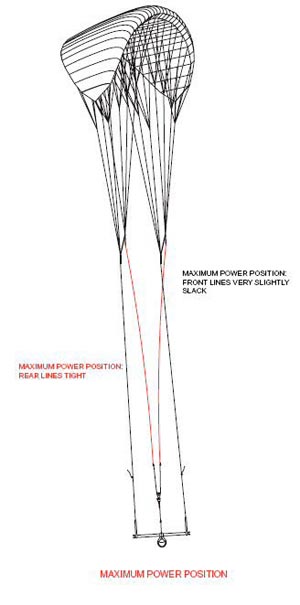 In the picture to the left, the kite is fully powered. In comparison with the other picture, you can see that the kite is tilted upwards. This increases lift and power, but also increases drag, making the kite slower through the air.
In the picture to the left, the kite is fully powered. In comparison with the other picture, you can see that the kite is tilted upwards. This increases lift and power, but also increases drag, making the kite slower through the air.
A depower foil works by bundling the brake bridle together with part of the power bridle to create, in effect, a second power bridle. The flying lines from the brake bridle go to the tips of a special bar, whilst the power lines go through a hole in the middle of the bar and are attached directly to a harness via a ‘chicken loop’ as shown below.
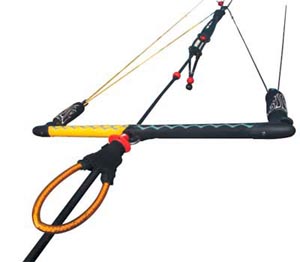 The bar is not in a fixed position, but has a limited range of movement up and down the lines. When the bar is pulled in toward the kite flier, as in the ‘maximum power’ picture above, the combined brake and power bridles are tensioned, changing the pitch of the kite upwards and increasing the power and upwards lift. Equally, when the bar is pushed away by the kiter, the ‘brake’ bridle is slackened off and the kite returns to its minimum power position.
The bar is not in a fixed position, but has a limited range of movement up and down the lines. When the bar is pulled in toward the kite flier, as in the ‘maximum power’ picture above, the combined brake and power bridles are tensioned, changing the pitch of the kite upwards and increasing the power and upwards lift. Equally, when the bar is pushed away by the kiter, the ‘brake’ bridle is slackened off and the kite returns to its minimum power position.
By careful placement of the bar, you can control precisely how much power is put out by the kite. This can be very handy in gusty conditions, as the power can be adjusted to compensate for the wind strength.
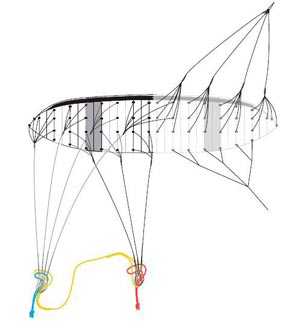 You can see in this picture how the two bridles are combined, then joined together to limit the movement of the bar.
You can see in this picture how the two bridles are combined, then joined together to limit the movement of the bar.
Different kites have more or less effective depower systems, with some kites able to go from almost no power to full power very easily. There are a few other ways of altering the power output of a depower kite, such as trimmer straps. In the case of some kites, an extra cleat is fitted onto the power lines just in front of the bar. By pulling on a rope attached to the power lines, it is possible to lock off the lines at a given position and use the bar for fine tuning the amount of power you want.
The Peter Lynn venom has a further contribution to depower ,“ it has a trimming strap inside the kite itself, meaning that the range of depower available in this case is extremely large.
A depowerable kite has less power (even when fully powered up) than the same sized fixed bridle kite. So a 9m depowerable will have, as a rule of thumb, the power of roughly a 6m fixed bridle kite, though there are a number of other factors that affect the power output. The advantage is that a depowerable kite can be safely flown in winds where an equivalent fixed bridle kite would be completely overpowered and unmanageable. They can be used in a much wider range of wind conditions.
On land, depower kites are mostly used for kiteboarding and buggy jumping, as they work best with air flowing over them (called apparent wind, created by the constant movement of the kite when boarding etc). They can be used for static flying, but normally fixed bridle kites have the advantage there.
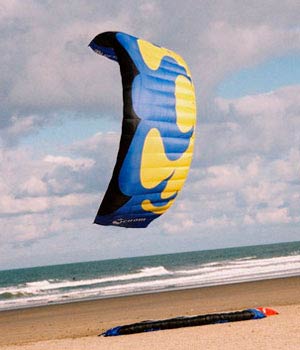 Depowerable kites are also used for kitesurfing on water, though the kites used in this case are almost invariably ‘closed cell’ or ‘leading edge inflatable’ kites, meaning that they are inflated then sealed off, so they can be landed in water without any getting inside the kite and making it impossible to fly. It is important to use depowerable kites on water because kitesurfing needs much more power than land based activities, a depowerable kite can be launched on minimum power, then the power increased to the necessary level once you’re out on the water.
Depowerable kites are also used for kitesurfing on water, though the kites used in this case are almost invariably ‘closed cell’ or ‘leading edge inflatable’ kites, meaning that they are inflated then sealed off, so they can be landed in water without any getting inside the kite and making it impossible to fly. It is important to use depowerable kites on water because kitesurfing needs much more power than land based activities, a depowerable kite can be launched on minimum power, then the power increased to the necessary level once you’re out on the water.
Disadvantages of depower kites:
They are more difficult to fly than fixed bridle kites because of the extra dimension of complexity involved. Also for the most part, they don’t fly well (or at all) in below about 8mph, with some kites needing almost double this windspeed. This trend continues as the size of the kite increases – even the biggest depower can’t be flown in low winds with much ease. Fixed bridle kites, however, have far better low wind capabilities.
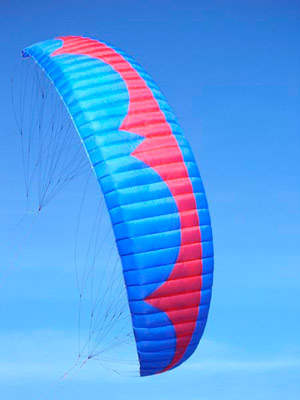 Types of depower kite:
Types of depower kite:
There are various types of depowerable kite, such as C-shape LEI’s, depowerable foils (covered in detail above) and bow kites. LEI stands for Leading Edge Inflatable, as these are single skin kites with an inflatable bladder in the leading edge which controls the shape of the kite, thus dispensing with the need for bridle lines. These are also depowered by changing the angles of attack, as are bow kites, but the methods are different in both cases. Bow kites are a cross between LEI’s and foil kites, they feature the best aspects of both including an excellent depower system and massive wind range.
Depower and fixed bridle kites – a comparison:
Depower kites: – Much greater wind range – More complex to fly – Good for boarding and buggy jumping. Not so good (generally) for static flying. – Able to jump much higher – Generally much more expensive – Can be made much bigger
Fixed bridle kites: – Not such a good wind range, you need to change kite size often as the wind speed increases. – Much simpler to fly – Good for static flying as well as boarding and buggy racing – Not able to jump as high (safely) – Generally better value for money – Power can be difficult to control beyond 9/10m, though some racekites go larger; e.g. u-turn nitro (15.4m)
Depower kites on handles:
Whilst it is possible to fly a depower kite on handles and have it power up by pulling the brake lines, you lose the effect of the depower system and you’re left with a low power, heavy fixed bridle kite with bad low wind capabilities and (obviously) no depower.
I hope this has helped to clear up any questions you might have. I’m going to add just one more section:
Developments in depower:
No-one is exactly sure who made the first depower kite, though whoever it was, depower kites have come on leaps and bounds since then.
The latest generation of bow kites has been launched this year. A cross between foils and LEI’s, these kites are easier to fly than ever and they have a total depower system as you can power down from full, 40ft jumping power to no power at all, and stand there as the kite comes down in 30mph. Modifications are being made all the time to existing depower kites, with many manufacturers now attempting to reduce the complexity of the bridle system by supporting the kite internally whilst retaining the performance characteristics of a bridled kite.
With kiting technology changing constantly, I’m looking forward to seeing what comes out next and then flying it!
Sourced https://www.tractionkiting.co.uk/
My friend Angus Campbell, Coastal Wind Sports has complied an excellent reference for helping to choosing a power kite.
Choosing your First Traction Kite
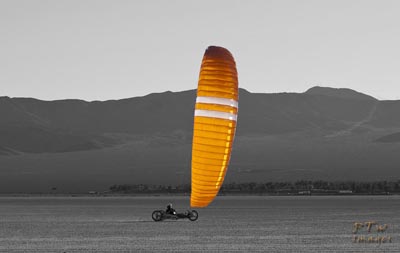
4 Line Power Kite
Another Very good reference from my friend Kent at
https://www.awindofchange.com/index.html
Power or Traction Kites
Power kites do what the name implies, generate power! These kites are some of the largest and most powerful kites you can purchase. Some power kites can reach sizes over 15 feet long or over 6 feet tall. If you are wanting to get into the extreme sport of power kite flying, we suggest you start out small, and preferably with an instructor or another experienced power kite flyer. If you master the art of flying quad line stunt kites, quad line power kites will be a breeze. In most cases, quad line power kites fly the same as quad line stunt kites other than the massive increase in power. The same goes for dual line power kites and dual line stunt kites. The skills you learn flying one can be easily applied to the other.
Power kites are extreme in size and power, always use caution and common sense when flying. Because of the extreme power generated by these kites, we always recommend starting out with a small kite or “trainer” kite. Power kite flyers usually have several kites in their kite collections and can usually show you the first kite they bought and the last one they bought. The reason is because they still fly every kite they have. On extremely windy days, the small trainer kite is the only one they are able to put up in the air and still keep their feet on the ground. The lighter wind days is the time the larger kites get pulled out.
We recommend starting with the Ozone 2.1 sq. Meter Little Devil or the Ozone 3.0 sq. Meter Little Devil. These two kites can take a lot of abuse and generate very impressive pull for their size. In winds of 10-15 MPH plus, the 3.0 meter Little Devil is an excellent choice for a buggy engine. On lighter wind days the 2.1 and 3.0 makes a perfect kite to learn on, giving you the ability to learn how a power kite pulls. Once again, power kites generate power! Don’t launch a giant power kite in huge winds…you can get seriously hurt!
Power kiting takes about the same amount of time to learn as stunt kite flying and can be learned in just a couple hours with the proper instructor. The more you fly both stunt and power kites, the better you will get at flying them. Learning to Buggy, Mountain Board, Surf, Snow board etc… will of course take longer to learn, but once you master the kite, you will be able to move onto the others easier and learn faster.
Before you purchase any kite, make sure it is what you want. If you don’t know for sure, ASK! We would rather help you find a kite that will do what you want it to do than sell you a kite that you find out later isn’t what you wanted … even if it means getting you a kite of lesser money. My best advise is to fly before you buy. Many shops will have demo kites used for demonstrations, ask your local shop if they have demo kites and when they will be demonstrating their kites. Ask to fly one or several different models at that time, listen to your local shop owner as they should have the best information about the kites and what you will need. Check with your local shop for any local groups that frequently fly in your area, try to meet up with them and ask them about their kites and what they like or dislike about the brand and sizes they currently own. Ask what kite they prefer or would rather have, ask about any type of kite you are considering on purchasing, maybe they have already purchased that kite and can give you some hands-on information about it. Try to keep an open mind about the information you receive as bias opinions are common – like automobiles, the chevy lovers will hail the Chevy’s and the Ford lovers will do the same. Try to fly all brands and find one that fits your style the best.
How many kites do I need to buy and which ones are the best?
As you fly you will discover why kite flyers have so many different types of kites in their collections. Every kite flies differently, every manufacturer has their own advantages and disadvantages. This kite may pull harder than that kite but that kite is faster than this kite. The debate on which kite is the best will probably outlast the debate on which car is the best and we definitely don’t have time for that one. I tell everyone who asks me which kite is the best the same thing…no kite is the best and no kite is the worst, they all are the best at what they can do. My friends and co-workers all go to the same park to fly as I do, we all fly in the same wind. Some fly Sky Tigers, some fly Blades, some fly Ozone’s, some fly inflatables, some fly dual line, some fly quad line … I fly C-quads. We all have flown each others kites and have great respect for all of them. If you feel comfortable with the kite you have, it is the best kite for you. It all boils down to personal preference and everyone is different.
As for the amount of kites you need? It isn’t the amount of kites you need, but the amount of kites you want. Every kite I have purchased has been for a reason, either I wanted a kite for lighter winds or for heavier winds … or I wanted a kite that was faster or more controllable. It all depends on what you want when you go to the park to fly.
With power kites, the wind is a main factor when it comes to purchases and in almost every case, is the only reason for purchasing different kites. Most power kite flyers will purchase several kites of different sizes for different wind conditions, and will usually only purchase from the same manufacturer as their first kite. If you find that the kite you have is just to big to fly most of the time, you will soon be wanting a smaller one and vise-versa if you find that the kite you have just doesn’t keep up with the larger ones in the lighter winds. Purchasing a smaller or larger version of the kite you already have eliminates the need to learn to control the new kite. Changing from one size kite to another of the same manufacturer is like shifting gears in your car, everything flies the same and controls the same, the power is just different.
To sum it all up, decide what type of kite flying you want to, and if possible, decide what type of kite flying you would like to advance into later if any. Then do some research on the kites in your selected fields. Check the manufacturer out, make sure there are parts available in case your kite needs repair. Check the wind recommendations of the kite you are looking at, make sure the wind speeds will fit in for your area. Last, find a color that fits with your personality (we know, this is now the hardest choice of all).
Information sourced from
